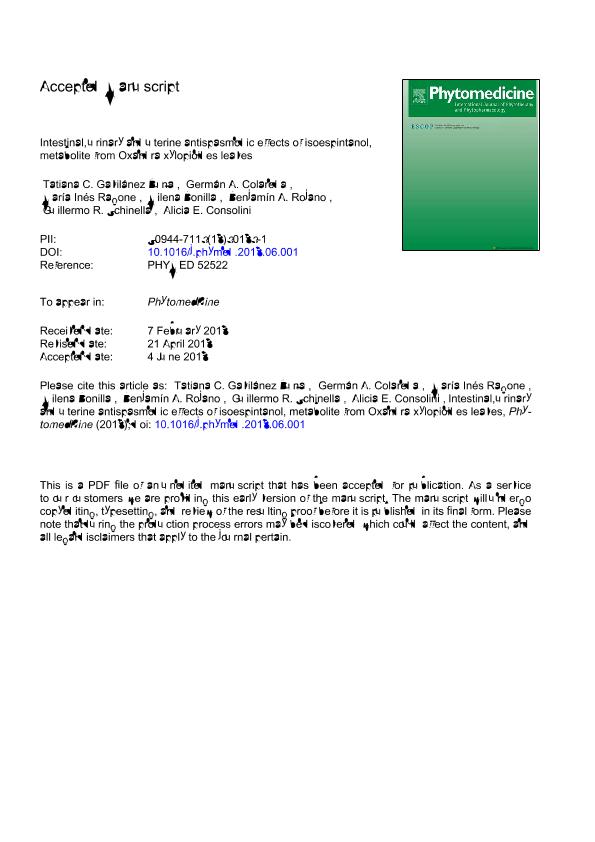Artículo
Intestinal, urinary and uterine antispasmodic effects of isoespintanol, metabolite from Oxandra xylopioides leaves
Gavilánez Buñay, Tatiana C.; Colareda, German Andres ; Ragone, María Inés
; Ragone, María Inés ; Bonilla, Milena; Rojano, Benjamín A.; Schinella, Guillermo Raúl; Consolini, Alicia Elvira
; Bonilla, Milena; Rojano, Benjamín A.; Schinella, Guillermo Raúl; Consolini, Alicia Elvira
 ; Ragone, María Inés
; Ragone, María Inés ; Bonilla, Milena; Rojano, Benjamín A.; Schinella, Guillermo Raúl; Consolini, Alicia Elvira
; Bonilla, Milena; Rojano, Benjamín A.; Schinella, Guillermo Raúl; Consolini, Alicia Elvira
Fecha de publicación:
12/2018
Editorial:
Elsevier Gmbh
Revista:
Phytomedicine
ISSN:
0944-7113
Idioma:
Inglés
Tipo de recurso:
Artículo publicado
Clasificación temática:
Resumen
Background: Isoespintanol is a monoterpene isolated from the leaves of Oxandra xylopioides Diels. (Annonaceae) with antioxidant and antiinflammatory effects. It was of interest to know whether it has antispasmodic effects such as other known drugs, phloroglucinol and trimethoxybenzene, used in therapeutics for treating biliary, urinary and uterine spasms. Purpose: To assess whether isoespintanol possesses antispasmodic effects on intestine, uterus and bladder. Study design: A preclinical study was performed in which isoespintanol, phloroglucinol and trimethoxybenzene were evaluated with concentration–contractile response curves (CRC) of carbachol in isolated rat intestine and bladder, and with CRC of serotonin (5-HT) in rat uterus. Moreover, it was assessed whether isoespintanol interferes with Ca2+ influx by making CRC of Ca2+ in high-K+ medium in intestine and bladder. Results: Isoespintanol non-competitively inhibited the CRC of carbachol with affinity constant (pK) of 4.78 ± 0.09 in intestine and 4.60 ± 0.09 in bladder. Phloroglucinol and trimethoxybenzene were also non-competitive antagonists, but isoespintanol was 8 times more potent than trimethoxybenzene and similarly potent than phloroglucinol in intestine. In bladder, isoespintanol resulted 8 times more potent than trimethoxybenzene. The maximal inhibition of contraction followed the order of isoespintanol > trimethoxybenzene > phloroglucinol in intestine, and isoespintanol > trimethoxybenzene in bladder. Moreover, isoespintanol also completely and non-competitively inhibited the CRC of Ca2+, with a pK of 5.1 ± 0.1 in intestine, and 4.32 ± 0.07 in bladder. In uterus isoespintanol reduced, completely and non-competitively, the contraction produced by 5-HT with pK of 5.05 ± 0.07. Conclusion: Results demonstrate that isoespintanol is a very good intestinal, urinary and uterine antispasmodic, with higher potency than the other drugs used in therapeutics. The mechanism of action of isoespintanol is the interference with Ca2+ influx, at a difference of trimethoxybenzene and phloroglucinol.
Palabras clave:
ANTISPASMODIC
,
CALCIUM
,
DETRUSOR
,
INTESTINE
,
ISOESPINTANOL
,
UTERUS
Archivos asociados
Licencia
Identificadores
Colecciones
Articulos(CCT - LA PLATA)
Articulos de CTRO.CIENTIFICO TECNOL.CONICET - LA PLATA
Articulos de CTRO.CIENTIFICO TECNOL.CONICET - LA PLATA
Citación
Gavilánez Buñay, Tatiana C.; Colareda, German Andres; Ragone, María Inés; Bonilla, Milena; Rojano, Benjamín A.; et al.; Intestinal, urinary and uterine antispasmodic effects of isoespintanol, metabolite from Oxandra xylopioides leaves; Elsevier Gmbh; Phytomedicine; 51; 12-2018; 20-28
Compartir
Altmétricas



